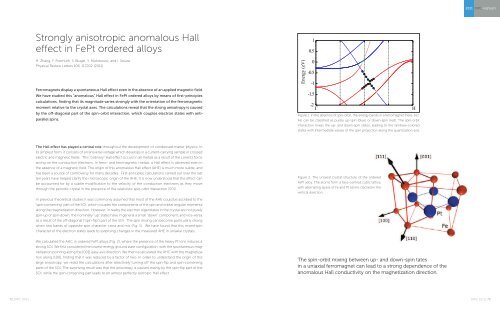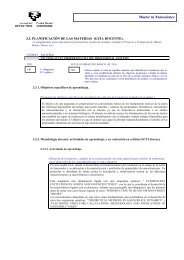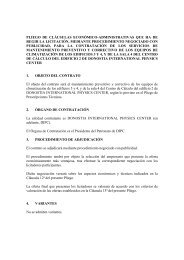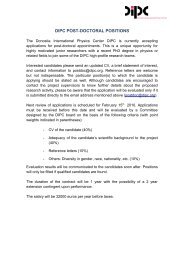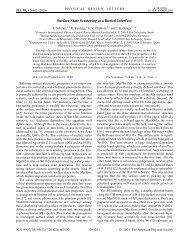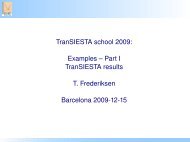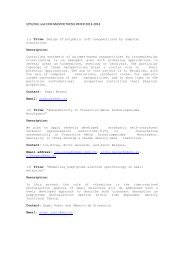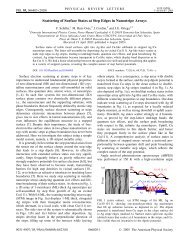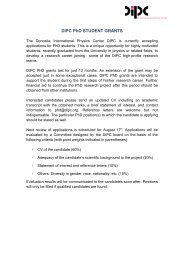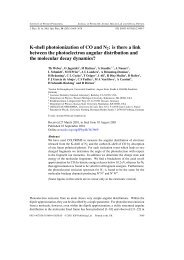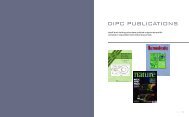Complete report - Donostia International Physics Center - Euskal ...
Complete report - Donostia International Physics Center - Euskal ...
Complete report - Donostia International Physics Center - Euskal ...
Create successful ePaper yourself
Turn your PDF publications into a flip-book with our unique Google optimized e-Paper software.
2011 DIPC Highlight<br />
Strongly anisotropic anomalous Hall<br />
effect in FePt ordered alloys<br />
H. Zhang, F. Freimuth, S. Blugel, Y. Mokrousov, and I. Souza<br />
Physical Review Letters 106, 117202 (2011)<br />
Ferromagnets display a spontaneous Hall effect even in the absence of an applied magnetic field.<br />
We have studied this "anomalous" Hall effect in FePt ordered alloys by means of first-principles<br />
calculations, finding that its magnitude varies strongly with the orientation of the ferromagnetic<br />
moment relative to the crystal axes. The calculations reveal that the strong anisotropy is caused<br />
by the off-diagonal part of the spin-orbit interaction, which couples electron states with antiparallel<br />
spins.<br />
Energy (eV)<br />
1<br />
0.5<br />
0<br />
-0.5<br />
-1<br />
-1.5<br />
-2<br />
Γ<br />
Figure 1. In the absence of spin-orbit, the energy bands in a ferromagnet (here, bcc<br />
Fe) can be classified as purely up-spin (blue) or down-spin (red). The spin-orbit<br />
interaction mixes the up- and down-spin states, leading to the rainbow-colored<br />
states with intermediate values of the spin projection along the quantization axis.<br />
H<br />
The Hall effect has played a central role throughout the development of condensed-matter physics. In<br />
its simplest form, it consists of a transverse voltage which develops in a current-carrying sample in crossed<br />
electric and magnetic fields. This "ordinary" Hall effect occurs in all metals as a result of the Lorentz force<br />
acting on the conduction electrons. In ferro- and ferrimagnetic metals, a Hall effect is observed even in<br />
the absence of a magnetic field. The origin of this anomalous Hall effect (AHE) is much more subtle, and<br />
has been a source of controversy for many decades. First-principles calculations carried out over the last<br />
ten years have helped clarify the microscopic origin of the AHE. It is now understood that the effect can<br />
be accounted for by a subtle modification to the velocity of the conduction electrons as they move<br />
through the periodic crystal in the presence of the relativistic spin-orbit interaction (SOI).<br />
Figure 2. The uniaxial crystal structure of the ordered<br />
FePt alloy. The atoms form a face-centred cubic lattice,<br />
with alternating layers of Fe and Pt atoms stacked in the<br />
vertical direction.<br />
In previous theoretical studies it was commonly assumed that most of the AHE could be ascribed to the<br />
"spin-conserving" part of the SOI, which couples the components of the spin and orbital angular momenta<br />
along the magnetization direction. However, in reality the electron eigenstates in the crystal are not purely<br />
spin-up or spin-down: the nominally "up" states have in general a small "down" component, and vice-versa,<br />
as a result of the off-diagonal ("spin-flip") part of the SOI. The spin mixing can become particularly strong<br />
when two bands of opposite spin character cross and mix (Fig. 1). We have found that this mixed-spin<br />
character of the electron states leads to surprising changes in the measured AHE in uniaxial crystals.<br />
We calculated the AHC in ordered FePt alloys (Fig. 2), where the presence of the heavy Pt ions induces a<br />
strong SOI. We first considered the lowest-energy ground state configuration, with the spontaneous magnetization<br />
pointing along the [001] easy-axis direction. We then recalculated the AHC with the magnetization<br />
along [100], finding that it was reduced by a factor of two. In order to understand the origin of this<br />
large anisotropy, we redid the calculations after selectively turning off the spin-flip and spin-conserving<br />
parts of the SOI. The surprising result was that the anisotropy is caused mainly by the spin-flip part of the<br />
SOI, while the spin-conserving part leads to an almost perfectly isotropic Hall effect.<br />
The spin-orbit mixing between up- and down-spin tates<br />
in a uniaxial ferromagnet can lead to a strong dependence of the<br />
anomalous Hall conductivity on the magnetization direction.<br />
72 DIPC 10/11<br />
DIPC 10/11 73


